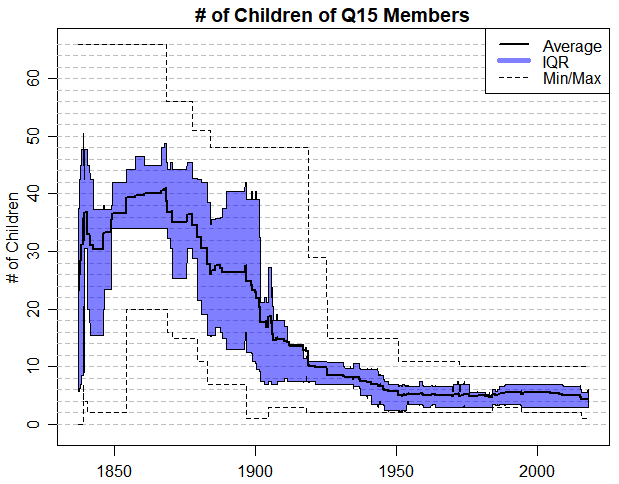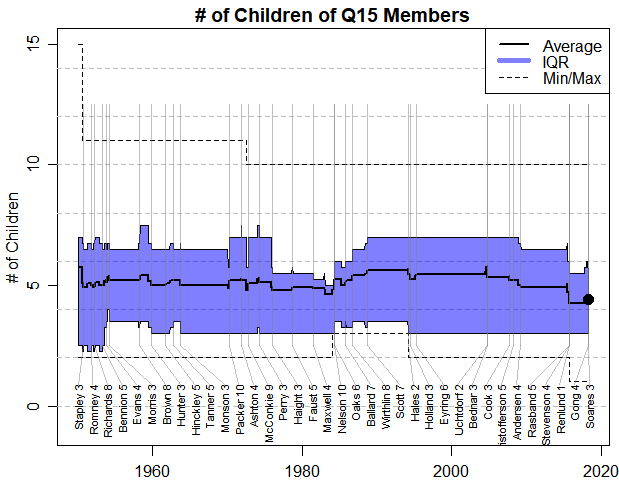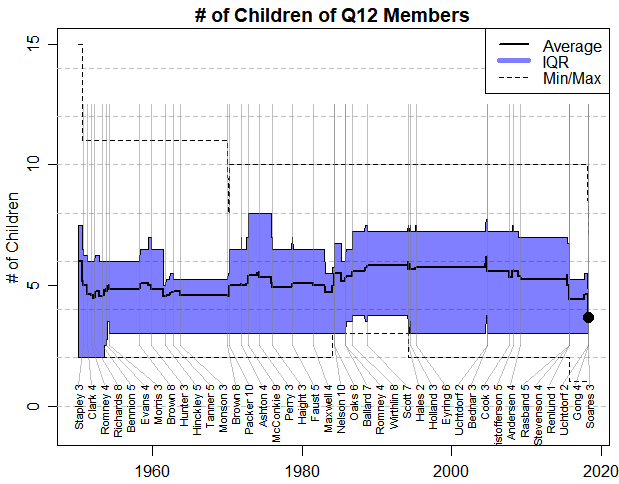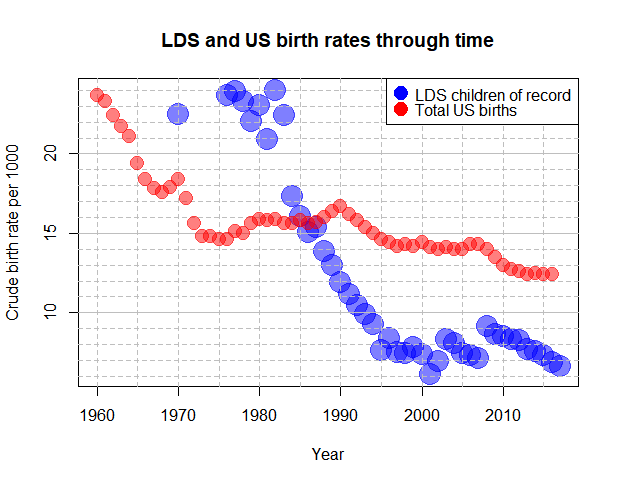This guest post comes to us courtesy of Christian N. K. Anderson.
Recently, a friend told me her bishop came up to her, touched her belly, and asked, “Sister, when are you going to bring more spirit children into the world?” In a similar vein, an Elders Quorum President recently told a different friend in a different state that it was too bad she had only three children, as he had seven and they were all successful. The five married couples in my wife’s family have so far collectively produced one child, and we routinely swap stories of being criticized or asked openly by virtual strangers to justify this state of affairs. Why does this happen so frequently?
One of the ways Jello-Belt LDS culture is increasingly out-of-step with contemporary US culture is the belief that fecundity is positively correlated with virtue. Some of this no doubt stems from over-the-pulpit exhortations that “The commandment to multiply and replenish the earth has never been rescinded” (Packer, Apr 2015, compare first paragraph of the FamProc), the fetishizing of the family (as an institution, but with vigorous legal opposition to many instantiations of LDS families), and explicit direction to have children even when financially unable to do so (Andersen, Oct 2011; quoted and enhanced in the Eternal Family Sunday School manual). This empowers people like the bishop and EQP mentioned above to feel no qualms about intruding themselves into what would otherwise be a profoundly personal decision: they are simply encouraging fellow saints to become better humans by performing the Kantian categorical morally good act of having another child (no matter the circumstances) the same way they might encourage a fellow saint to forgive an enemy or visit a sick member.
These beliefs and rhetoric are increasingly anachronistic, not just in contemporary US culture, but among LDS members, and also among the LDS leaders who continue to make these sweeping generalizations. While a 2015 lesson manual encourage teachers to express disapproval for a US fertility rate that has dropped 45% since 1960, it fails to mention that rate at which LDS members reported their children fell by 70% over a far briefer period: from 24.2 children of record per 1000 members as recently as 1982 to 7.32 in the year of the manual’s publication. It has continued to decrease to 6.62 according to the most recent April 2018 statistical report. Of course, this is tracking children of record, not total number of births; with activity dropping below 33% in the US and 15% in Central America, a large number of babies born to nominal members are likely never recorded by ward clerks. Nevertheless, I expected this underreporting to be partially offset by church growth in countries with birth rates far higher than the United States’.
Sources: https://data.worldbank.org/indicator/SP.DYN.CBRT.IN?locations=US, http://www.fullerconsideration.com/membership.php#childrenofrecord. For information on earlier time periods, see Fig 1 of https://dialoguejournal.com/wp-content/uploads/sbi/articles/Dialogue_V10N02_14.pdf.
Similarly, LDS leadership has undergone a radical decrease in lifetime reproduction. From Dec 1848 to August 1877, not a single member of the first presidency and quorum of the 12 apostles (hereafter Q15) had fewer than 20 children, and average fertility hovered in the high-30s for most of the second half of the 19th century. It reached an absolute peak of 40.9 children per leader from October 1867 to June 1868 after the excommunication of Amasa Lyman (38 children) and before the appointment of Brigham Young, Jr (16). Even before the manifesto, this number had declined considerably to the mid-20s for most of the 1890s. After a brief spike to 27.5 following the ouster of Moses Thatcher (11) in 1896, the average plummeted down to 10.0 in January 1919, the final plunge occurring after the death of Joseph F. Smith (48) and the appointments of Melvin J. Ballard (8) and Richard R. Lyman (2). In the 1920s, ‘30s, and ‘40s, the average number of leaders’ children declined gradually from 10 to about 5.
 From 1950 to 2015, the average number of children in the Q15 was nearly unchanged, barely fluctuating from a maximum of 5.77 to a low 4.64. However, in 2015 the deaths of Perry (3), Packer (10), and Scott (7) and their replacement with Rasband (5), Stevenson (4), and Renlund (1) brought the leadership’s average to the historic low of 4.27. It rebounded only slightly in April 2018 with Gong (4) and Soares (3) replacing Hales (2) and Monson (3), bringing us back up to the second-lowest value in LDS history of 4.40 children per leader.
From 1950 to 2015, the average number of children in the Q15 was nearly unchanged, barely fluctuating from a maximum of 5.77 to a low 4.64. However, in 2015 the deaths of Perry (3), Packer (10), and Scott (7) and their replacement with Rasband (5), Stevenson (4), and Renlund (1) brought the leadership’s average to the historic low of 4.27. It rebounded only slightly in April 2018 with Gong (4) and Soares (3) replacing Hales (2) and Monson (3), bringing us back up to the second-lowest value in LDS history of 4.40 children per leader.
 The recent trend in the Q12 has been even more pronounced. With Nelson (10) and Oaks (6) leaving for the first presidency, while Uchtdorf (2) rejoined the Quorum, the average number of children has dropped to 3.67, a full 0.75 (20%) lower than the second lowest value in Quorum history.
The recent trend in the Q12 has been even more pronounced. With Nelson (10) and Oaks (6) leaving for the first presidency, while Uchtdorf (2) rejoined the Quorum, the average number of children has dropped to 3.67, a full 0.75 (20%) lower than the second lowest value in Quorum history.
 Does any of this mean anything for the future? Possibly. It comes as no surprise that leaders’ families became much smaller after polygamy, but it was something of a surprise to me that this trend was already firmly established prior to 1890; the change in demography preceded the change in policy. Perhaps history will repeat itself. It is true that we just went from a prophet with just 3 children to one with 10, but historically a prophet’s family size has had little effect on rhetoric (Lee had 2, George Albert Smith 3, Hunter 3, and Kimball 4, yet all presided during a period where fertility was vigorously encouraged), and that potential personal bias is countered by a lot of other factors. The only other leader in recent history with double digit children was Boyd K. Packer, and the remaining members of the Q15 with 7 (Ballard) or 6 (Oaks and Eyring) children are also the three oldest after Nelson. It will be harder for apostles with fewer children to claim without hypocrisy that God wants everyone to have as many children as economically possible or more. It’s one thing for Rudger Clawson, father of 10 addressing a largely agrarian church in 1916, to tell members to have children “to the utmost limit”, but something else for Andersen, a Harvard MBA with four children, to say basically the same thing in 2011. It also requires even those leaders with many children to think twice before saying something too strident in front of Uchtdorf (2 children) or Renlund (whose only child, Ashley, remains unmarried in her late 30s). The FamProc, already a political embarrassment, will increasingly become a personal one as well. Finally, when the Q12 has nine members with four or fewer children, it becomes clear that high fertility is no longer necessary for authority, and more difficult for local leaders to pressure members to increase their family size. Given all this, I conclude that we can anticipate an uncoupling of virtue and reproduction in both official rhetoric and lay belief within the next (modestly-sized) generation.
Does any of this mean anything for the future? Possibly. It comes as no surprise that leaders’ families became much smaller after polygamy, but it was something of a surprise to me that this trend was already firmly established prior to 1890; the change in demography preceded the change in policy. Perhaps history will repeat itself. It is true that we just went from a prophet with just 3 children to one with 10, but historically a prophet’s family size has had little effect on rhetoric (Lee had 2, George Albert Smith 3, Hunter 3, and Kimball 4, yet all presided during a period where fertility was vigorously encouraged), and that potential personal bias is countered by a lot of other factors. The only other leader in recent history with double digit children was Boyd K. Packer, and the remaining members of the Q15 with 7 (Ballard) or 6 (Oaks and Eyring) children are also the three oldest after Nelson. It will be harder for apostles with fewer children to claim without hypocrisy that God wants everyone to have as many children as economically possible or more. It’s one thing for Rudger Clawson, father of 10 addressing a largely agrarian church in 1916, to tell members to have children “to the utmost limit”, but something else for Andersen, a Harvard MBA with four children, to say basically the same thing in 2011. It also requires even those leaders with many children to think twice before saying something too strident in front of Uchtdorf (2 children) or Renlund (whose only child, Ashley, remains unmarried in her late 30s). The FamProc, already a political embarrassment, will increasingly become a personal one as well. Finally, when the Q12 has nine members with four or fewer children, it becomes clear that high fertility is no longer necessary for authority, and more difficult for local leaders to pressure members to increase their family size. Given all this, I conclude that we can anticipate an uncoupling of virtue and reproduction in both official rhetoric and lay belief within the next (modestly-sized) generation.

I love data analysis posts. Thanks!
I’m shocked by the 24.2 children of record per 1000 members.
Isaacson and Dyer are not included as members of the FP (though it would be the Q17 at the time, not just the Q15). What effect would their inclusion have?
Having a little trouble with some of your math. If the average dropped to 4.27 with the three apostles called in 2015, how could it increase to 4.40 with the addition of Gong and Soares, who have 4 and 3 children, respectively? They should actually drop the average further, since both are below the 4.27 figure.
I do find it interesting the nosy neighbors who inquire about such intimate and personal affairs. What can be more private than a couple’s decision or ability to have a certain # of kids.
That being said, I think the first 5 minutes of Idiocracy should be mandatory viewing for couples.
Left Field: Both Thorpe B Isaacson (who wasn’t an apostle, but was an assistant to the Q12 and counselor) and Alvin R Dyer (who was an apostle, but not officially part of the Q12) had 2 children. During the period they both served from Oct 1967 to Nov 1970, they would have decreased the average number of children from 5.00 to 4.65; slightly further following the deaths of Hugh B Brown (8) and David O McKay (7) in early 1970.
Good catch, Wally! It’s because they replaced Hales (2) and Monson (3). The text is now being edited to clarify.
Fertility is more than a yes/no matter. Some can have one or three, for which they are very grateful, though they would have had more if their bodies had allowed. That can even be the case for someone like Flora Amussen Benson who the March ’87 Ensign quoted, “I wanted twelve children, but had to settle for a choice half dozen. If we just would have had twins every time, we would have made it.”
Utah leads the nation in household size (3.14 persons compared to nat’l avg. of 2.4). The cost of raising a child to the age of 18 is now $233,600 (does not include missions or college). Utah does well as to student loan debt with 41% of graduates having avg. debt of $18,900 (lowest in the nation). Utah also leads the nation in charitable giving (10.6% of all salaries – nat’l avg. around 4%) and it leads in volunteer hours. Utah’s per capita income is the 46th lowest in the nation. Utah is always in the top 5 of per capita bankruptcy filings (4.7 filings per 1,000 citizens compared to nat’l avg. of 2.5).
That Utah leads the nation is per capita bankruptcy filings is the result of many factors, but they include that Utahans have larger families, make less money, and devote more of their income and time to charity. Certainly admirable, but not without financial consequences as to individual families.
The Church’s counsel on this subject needs to be tempered with the changing economics of the cost of higher education, the necessity of adequate insurance, and a clear understanding of what it really costs to provide for and to raise a family.
As an aside, the Twelve are exceptionally smart and talented individuals with Type-A personalities. For them, accomplishing feats such as raising kids and becoming doctors, lawyers, business leaders, etc. seems a realistic possibility. However, the majority of Church members are not so endowed. I fear the Twelve sometimes fail to appreciate that what is achievable by them is difficult, if not impossible, for the membership at large. A broad statement that everyone should have as many kids as possible without regard to financial realities is problematic counsel. One size does not fit all.
For anyone still reading, I’ve applied Christian’s updates that clarify the issue Wally raised and also modify the last paragraph.
It always hurt my mom who only had 2 loving children and dealt with 7 lost children to miscarriage, death, and still birth.